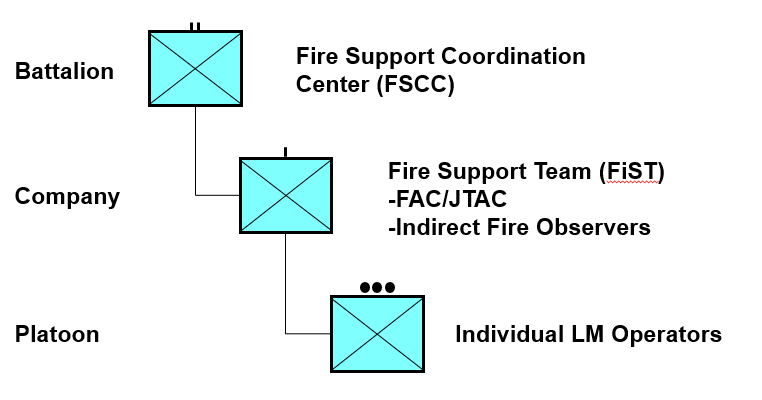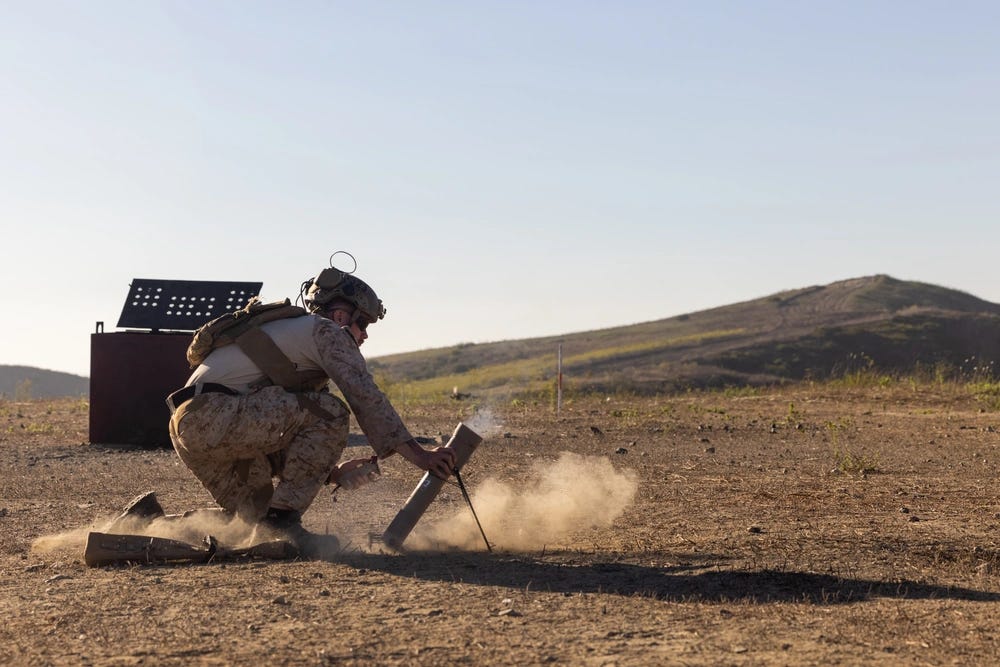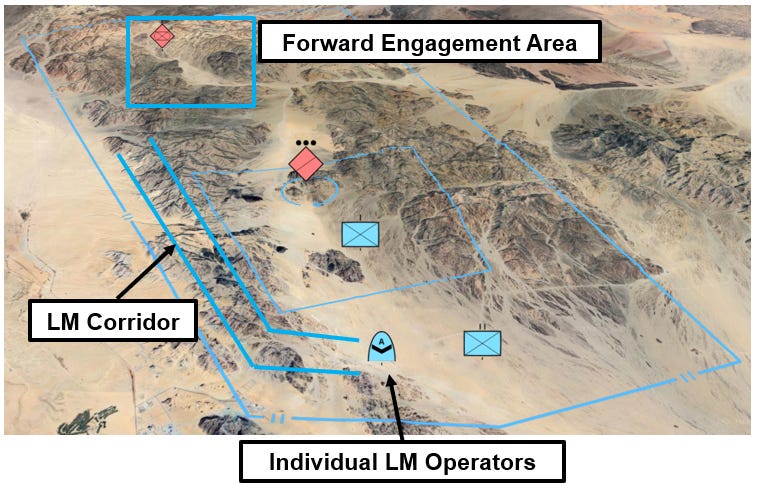Marine Corps Loitering Munitions: Ten Tenets for Future Employment Modeling Infantry Organic Precision Fires
A CxFile - War Quants Collaboration
Editor’s Note: The Connecting File is fortunate to team up with another great group of Marines over at War Quants to produce this article. War Quants examines defense issues, national security strategy, and defense tech trends through a quantitative and data-driven lens. You can read more of their work, like ‘One Million Suicide Drones with Chinese Characteristics’, here.
Over the past few years, loitering munitions have moved from the margins of conflict to the center of modern warfare. Anyone watching the evening news has seen them disrupt armored columns, deny key terrain, and redefine what it means to shape the battlespace—all at the tactical edge. With the upcoming delivery of Organic Precision Fires, the Marine Corps is joining the trend.
Integrating loitering munitions into the Marine Corps is not just about buying the right drone or writing the right CONOPS. It’s about rethinking how we generate combat power, organize for distributed operations, and equip Marines who fight in every clime and place.
The Corps faces several critical questions:
Should every squad carry a loitering munition? How many?
Who controls fires from above—platoon or battalion?
How do we sustain these systems forward, in a fight, with contested logistics?
And how do we ensure that loitering munitions enable the rifleman in the chaos of combat instead of distracting him?
These are not just immediate tactical questions. They’re larger questions of doctrine, force design, and leadership.
This article proposes ten core principles developed through experimentation, analysis, and operational feedback. These tenets are meant to guide discussion on how the Marine Corps develops, employs, and adapts loitering munitions to its operations. Some will challenge traditional assumptions. Others will reinforce enduring truths. Together, they offer a vision for integrating this capability not as a bolt-on novelty, but as a core component of 21st-century Marine Corps warfighting.
Because at the end of the day, this isn’t just about drones. It’s about lethality, tempo, and giving Marines the tools to win—wherever the fight finds them.
I. Warfighting Foundations
1. Every Marine a rifleman, not every Marine an FPV operator
Loitering munitions support but do not replace the rifleman's foundational role. LMs enable maneuver, and their operation should not be a universal Marine Corps skillset. When synchronized with other MAGTF fires, LMs are accretive to total Marine Air-Ground Task Force lethality.

The infantryman’s training and readiness manual bursts at the seams, and the average battalion training and exercise employment plan (TEEP) is full. Individual Marines must master multiple optics, weapon systems, and other equipment, and then be able to synchronize their capabilities together in months to deploy as combat-ready units. The Marine Corps should carefully consider task saturation and span of control when integrating loitering munitions into its formations.
While many Marines should learn to be incidental operators of loitering munitions, drones should not replace the rifle in Marine culture. The Marine Corps should instead take a crew-served mindset to loitering munitions. For example, an 0311 can employ an M240B medium machine gun, but only in the hands of a 0331 does it become an art form.
Likewise, 0352 anti-tank guided missilemen or a new 03XX MOS could become specialists in loitering munitions and provide deep expertise to infantry battalions.
Current conversations even include Company and Battalion-level mortar sections, as well as fire support teams being tasked with OPF employment. Shaping the battlefield is critical for setting conditions, but maneuver will still need to close under suppression. Do these formations have the redundancy and bandwidth to take on another primary mission? Are we incurring risk in their ability to provide critical fire support at a decisive moment as we shift our fires mix towards loitering munitions?
2. Ounces equal pounds, and pounds equal pain
Every system must earn its place. Loitering munitions should offer high payoffs relative to the logistical and physical burden they impose. We must have high kill probabilities to justify the weight.
Analysts approach this problem through “knapsack optimizations.” Imagine a pack and the rifleman who carries it. Each pack has a limited cubic storage space and weight constraints. The additional equipment added must balance the equipment removed, so everything fits.
In the same way, the company commander will need to decide how many loitering munitions to carry. Imagine 10 organic precision fires-light (OPF-L) systems. Each system weighs 15 pounds, not including controllers and extra batteries. If the company commander takes all 10, that is 150 additional pounds of weight to distribute amongst foot mobile light infantry, corresponding to less 7.62mm ammunition and sustainment. In a triple canopy jungle that limits loitering munition employment, each round of 7.62mm may matter greatly.
Furthermore, the kill probability of loitering munitions directly drives lethality per pound. A commander with 10 OPF-Ls, each with a 20% probability of kill (P-kill), as observed in Ukraine, will achieve outcomes from the blue lethality distribution in the chart below. For Ukraine, an expected 20% P-kill works because it is only 585 kilometers from Kyiv to Donetsk. For the Marine Corps, an expeditionary force, it's 10,500 kilometers from San Diego to Okinawa. Materiel must travel much further to get to the fight; therefore, when it gets there, it must work. The orange distribution shows the lethality with a 90% kill probability. This is the loitering munition kill distribution the Marine Corps should strive to achieve.
3. Logistical realities matter. Munitions must be safe, easily stored, and supportable by forward-deployed forces without contractor dependency.
Just as the Ukrainians have contested logistics networks, any future Marine Corps fight in the first island chain will be contested. Analysts examine these issues using contested logistics network modeling.
There are multiple relevant considerations:
Software/Hardware Upgrades—If the Marine Corps prepositions stockpiles forward, how will these systems receive software and hardware upgrades?
What are the implications for battery degradation in long-term storage? Are climate-controlled magazines necessary?
Should and will Marines be able to modify these systems for different missions on site, once the battle commences?
Can and should the Marine Corps consider expeditionary manufacturing at forward bases and stations? Would this take too many Marines out of the fight?
How do we meet power requirements at the FLOT while conducting signature management?
These are just a few of the DOTMLP-F implications of integrating loitering munitions. Because of these considerations and more, the Marine Corps is unlikely to have a $500 loitering or FPV attack munition anytime soon. Fuzes that use a couple of loops of copper wire, as shown in the photo below, are common in Ukraine. The Marine Corps requires something different due to its expeditionary nature. No US ship captain or aircraft commander would transport munitions like these, nor would they pass the Army munitions review process because they fit the definition of an improvised explosive device. Finding the balance of safety and cost will require additional experimentation through the Marine Corps Warfighting Lab and the new Marine Corps Attack Drone Team.
II. Integration and Control
4. Battlespace Design and Fires C2 Must Evolve.
New capabilities require updates to fire support coordination, battlespace construction, and the C2 architecture needed to employ loitering effects rapidly and safely.
Due to its combined arms focus, the Marine Corps has the fire support doctrine to integrate LMs quickly. However, it must carefully consider the impacts at each echelon. Traditionally, the 81mm established the infantry battalions' organic area of influence. OPF-L more than triples the range that a battalion commander can affect. A busier battalion airspace requires additional deconfliction by time and space. While operating areas can expand, and smaller units can control larger areas of battlespace, this change requires lower echelons to understand lateral and altitude deconfliction.

5. Employment Models Must Be Flexible, Modular, and Mission-Driven.
Loitering munitions must integrate into scalable, task-organized units—from squads to battalions. Strike authority must flex between decentralized and centralized control based on mission variables, tempo, and terrain.
Loitering munitions will be a high-demand, low-density asset for the foreseeable future. Consolidation for training could be required until there are sufficient systems and operators to meet demand. Additionally, Marine units may develop innovative new employment concepts that concept developers did not foresee. Traditional task organization of fires command and control assets supports this transition. FACs and JTACs have an immense opportunity to get creative.

We must remember that most allies and partners do not have the density of fire support coordination assets at the lower echelons that we do. This fact creates integration risk and opportunities. Combined operations with loitering munitions will take additional coordination. The trade-off is that Marines can support allies and partners even in non-contiguous areas of operations due to loitering munition range.

III. Tactical Employment
6. We Shape the Fight Before Contact.
Loitering munitions expand our influence beyond line of sight. They enable reconnaissance-strike integration and shaping fires in advance of traditional kinetic engagements.
Battalion commanders may want to consolidate OPF operators at the battalion level to weight specific efforts at different battle phases.
In this vignette, a company attacks up the Delta-T corridor in Twentynine Palms, California. Concurrently, a consolidated OPF section attacks a mechanized infantry company deep in a forward engagement area. These actions can be taken entirely with organic battalion assets.
7. LMs are hip-pocket close air support at the tactical edge
Battles in Ukraine have shown that Marines must deliver lethal, precision fires without requiring massed formations. Loitering munitions enable distributed units to generate timely effects across space and time, freeing air assets for alternative tasking.
When enough loitering munitions proliferate to the company level, company commanders can break the 72-hour Corps-level air tasking order. They can achieve effects typically requiring rotary-wing assets without exposing manned aircraft to unnecessary risk.
In this vignette, three companies mass loitering munitions on an adversary's amphibious infantry regiment as it comes ashore at Camp Pendleton. Top-down attack by loitering munitions onto ZBD-05s is catastrophic, and can result in the entire crew and infantry in the back going down with the vehicle. These companies, however, do not need to mass and expose themselves to concentrated fires.
IV. Scalability and Resilience
8. Fires must be available to Marines in every clime and place
Loitering munitions must function where Marines fight—from frozen littorals to dense jungle and arid desert. Weather, terrain, and time of day must never deny Marines fires. We don’t cede the battlefield to rain.
Senior leaders have multiple concerns about loitering munitions, but this is the most significant. If the Marine Corps changes its fires mix to include this capability, will it induce unnecessary risk into its fires architecture?
In the GCE fire stack, OPF-L complements cannon artillery. The Marine Corps will need both. If weather restricts loitering munitions and other small unmanned aerial systems, mortars and artillery must support maneuver.
This requirement implies that different climes may require different munitions. Marines in Norway may need batteries that are different from those in Syria. Our systems should accommodate that. Furthermore, closed terrain, such as jungle or urban environments, requires quad or multi-copter designs that allow more flexible attack angles. In contrast, long-distance strikes in open terrain can utilize fixed-wing loitering munitions with increased range.
9. Lethality at scale requires affordability at speed
Precision fires, namely loitering munitions, are only decisive when we can field them in volume, replace them rapidly, and afford to use them without hesitation. Our advantage lies not just in technology, but in scalable lethality.
Ukraine produced 1.5 million FPV attack drones in 2024. While the Marine Corps and Joint Force fight differently, we cannot ignore that mass matters. We modeled the possible production growth based on Ukrainian government statements that it scaled production from 20k/month to 200k/month.

These numbers suggest that Ukraine increased FPV density on the battlefield from 1.1 to 11 daily FPVs per mile of frontage. With 4.5 million FPV attacks drones planned for 2025, drone density on the battlefield will only grow.
Similarly, China plans to build millions of one-way attack drones.
The Marine Corps must effectively leverage the current US defense industrial base to get the loitering munitions it needs at scale for an acceptable price.
V. Strategic Alignment
10. We are amphibious, naval infantry supporting naval campaigning
Loitering munitions enhance the reach, tempo, and persistence of infantry forces in support of distributed maritime operations and sea denial objectives.
As much as the Marine Corps likes to differentiate itself from the Navy, we must not forget that it enables naval campaigning. OPF-L is a short-range capability in a world of cruise missiles.
The Marine Corps will require more extended-range loitering munitions to maintain relevance across distributed, contested environments. Luckily, efforts are underway through non-traditional acquisition pathways, such as the Replicator initiative, to accelerate capabilities outside standard programmatic timelines. Additionally, a strong grassroots movement is emerging at the tactical level, with units self-funding UAS experimentation under authorized programs.
Notable examples of innovation and experimentation include the Marine Corps Attack Drone Team at Weapons Training Battalion, Quantico, and Advanced Infantry Training Battalions – East & West.
Conclusion
Loitering munitions are more than just a new tool—they challenge us to rethink how we generate fires, task-organize, and build responsive and resilient combat power. From weight in the pack to cost per effect, from company-level hip-pocket close air support to dynamic fires coordination at the battalion, these ten tenets are meant to frame the integration conversation. This isn’t about replacing Marines or overcomplicating the fight—it’s about empowering the rifleman, shaping the battlefield before contact, and ensuring fires are available, adaptable, and under the right level of control. The opportunity is real—and so is the urgency. Our job is to scale what works, document what doesn’t, and make loitering munitions a core enabler of how Marines fight, not just another piece of gear in the ruck.
Major Sean Harper is currently serving as an Operations Research Analyst assigned to the Deputy Commandant for Combat Development and Integration. An infantry officer by trade, he co-founded War Quants. He can be reached at sean@warquants.com.
















In my mind I believe principles of loitering munitions employment should be something like the following (PICMDEEP, with loitering munitions capabilities):
Pairs We attempt to employ loitering munitions in pairs(squads) at all times. Loitering munitions employed in pairs should remain in Line of Sight of each other. Frequency and connection are key and dictate distance of separation. This allows us to duplicate fires to ensure continuous fire support even if one loitering munition goes down. This also gives us “mutual support”, giving us constant visual on the target and uninterrupted support during immediate action drills or if a loitering munition goes down or temporarily loses connection. Ground mortars/artillery can be integrated to the pairs if needed.
Interlocking flight paths/communication range Reinforce and double the firepower employed across the units frontage. This also ensures no area goes uncovered, especially when flight paths intersect
Coordination of Fires Dictates use of appropriate weapons to fire on appropriate targets. This allows maximum effectiveness of all weapons systems employed, to conserve ammunition, and to mask the loitering munitions position until their fires are required.
Mutual Support The weapons systems need to be able to support each other. If one loitering munition is down or fails, the other weapon needs to be able to fire the mission.
Defilade
Defilade for pilot allows us to pilot the loitering munition behind the mask of terrain outside the effects and observation of the enemy. This allows us to increase survivability of the position and the crew.
Enfilade Whenever we utilize loitering munitions, we attempt to achieve enfilading fires upon our enemy. By enfilade fires we mean that the long axis of the beaten zone coincides with the long axis of the target.
Economy By economy, we mean economy of our fires. We utilize the appropriate weapons systems in accordance with the threat. We establish engagement criteria for our loitering munitions to conserve ammunition, make sure the munition is appropriate to the threat and to ensure crew survivability.
Protection Obvious considerations need to be taken in the construction of loitering munition crew positions in order to ensure maximum survivability of the crew. Once the loitering munitions are ordered to engage, they will obviously become a focal point of the enemy. Cover and concealment are critical. The construction must be robust as well as moved frequently in order to ensure the continued support of their fires.
Beware the Rifle not becoming the Bayonet…